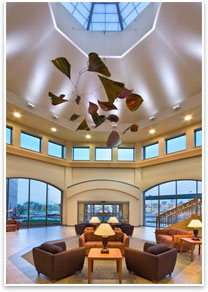
| Lucky Number Seven HGA and Sutter Roseville Med Center open 7th IPD project
Summary: The new $40 million Sutter Acute Rehabilitation Institute at Sutter Roseville Medical Center in Sacramento opened its doors to the community last fall. The last of seven campus projects designed by HGA Architects and Engineers, the 106,500-square-foot facility will serve patients disabled by spinal and brain injuries or illness in order to help them achieve maximum functional independence and the ability to return to the community. Visit HGA architects for additional information on the Sutter Acute Rehabilitation Institute and Sutter Roseville Medical Center. With the opening of the Acute Rehabilitation Institute, the Sutter Roseville has completed the first phase of its master plan. The campus currently offers its community 652,000 square feet of medical services. Sutter does have a long-range master plan in place and, when patient demands require more space, the medical center will eventually consist of 1.1 million square feet. The Acute Rehab Institute is a level II trauma center that provides 40 beds for rehabilitation patients and shell space for an additional 16 beds, which will be added when the community’s need increases. For more information on target-value design, read this article in Reforming Project Management entitled AIA “Hot Topic”: Target Value Design. For details on implementing the Last Planner System, check out this PDF from the Construction Innovation Forum. Do You Know AKR? See what else AKR has to offer for your practice. See what the Academy of Architecture for Health Knowledge Community is up to. Visit the Integrated Project Delivery page on AIA.org.
All images courtesy Vance Fox Photography. According to Bonnie Walker, AIA, principal in charge, HGA began working on the Sutter Roseville campus nearly a decade ago. In 2004, HGA did an ICU expansion where they worked in close collaboration with contractor Unger Construction. In 2005, HGA and Unger did a c-section area remodel and brought the mechanical builder and electrical subcontractor onto the team. “Mind you,” Walker says, “these are smaller projects that we started out with as a team. Over time, we improved our collaboration and our depth of integrated project delivery.” The team next did a 14,000-square-foot emergency department expansion in 2006. The following year, they completed a 90,000-square-foot, four-story bed tower, at which time they brought on board the steel manufacturer. In the spring of 2007, the team did a well-baby nursery that infilled an existing courtyard within a bed tower. The neonatal intensive care unit expansion was completed in spring 2008, and last fall the Acute Rehab Institute was opened. “What’s interesting is that we started out small,” recalls Walker. “We’ve been together the entire time and did project after project and we truly learned how to work together in an integrative, collaborative environment. Because of that, each project was successful…We were handed project after project without having to interview or go out in the competitive market with other architects. We just stayed on that campus and kept going through an entire master plan.” Walker believes that the key to the team’s success on the Sutter Roseville campus is their adherence to the IPD “Five Big Ideas”, Target-Value Design, and the Last Planner System. Five Big Ideas
In addition to the five big ideas, Walker credits the importance of target-value design, which is designing for a detailed budget instead of budgeting for a detailed design. The Sutter team divided their overall budget into different pieces or buckets, with each discipline designing to a particular bucket. The cardinal rule was that disciplines couldn’t go over their bucket. If going over proved necessary, then that discipline had to negotiate with another discipline to reduce their bucket in order to make funds available.
Of the IPD process and the relationships that developed, Walker says, “It was an evolution. Sutter was supportive of this process because of all the activity [they had planned]. They agreed to it right away. Of course, if something had gone wrong they would’ve changed course, but nothing went wrong because the process works. If you truly are collaborating, you’re going to end your project with success. I think that’s an important statement because for us to get repeat work time and time again, there’s obviously something positive going on. We were meeting our budgets. We were staying on schedule. They were satisfied, which is good.” |
||
Copyright 2009 The American Institute of Architects. All rights reserved. Home Page |
||
news headlines
practice
business
design

 How do you . . .
How do you . . . 
 Finally, the team used the last planner system which is organized around a reverse phase schedule. Every team member that influences the schedule came to a meeting where they started at the end of the project and worked backwards. “We create our schedule based on everybody’s input so everybody got buy-in and it’s created from the back forward,” explains Walker. “The reverse phase schedule is how you create it, and then it has a milestone schedule and a six-week look ahead. We constantly are looking at a short duration so that we can march through the process of what we agreed to.”
Finally, the team used the last planner system which is organized around a reverse phase schedule. Every team member that influences the schedule came to a meeting where they started at the end of the project and worked backwards. “We create our schedule based on everybody’s input so everybody got buy-in and it’s created from the back forward,” explains Walker. “The reverse phase schedule is how you create it, and then it has a milestone schedule and a six-week look ahead. We constantly are looking at a short duration so that we can march through the process of what we agreed to.”